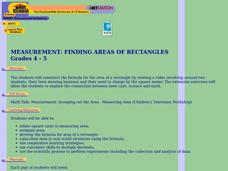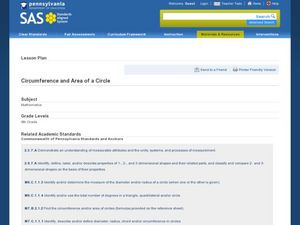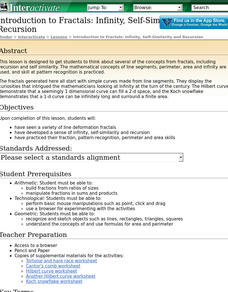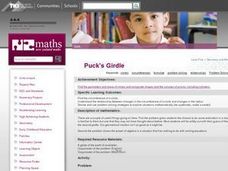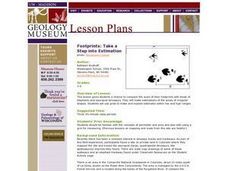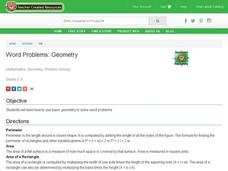Curated OER
Volume & Candy Creations Model
Sixth graders investigate surface area. In this surface area lesson, 6th graders design a box of candy that has a volume of 30 cubic inches. Students are trying to minimize surface area while keeping volume constant. ...
Curated OER
NON-EUCLIDEAN GEOMETRY.
Students study relationships between angles, side lengths, perimeters, areas and volumes of similar objects. In this instructional activity students also create and critique inductive and deductive arguments concerning congruency,...
Curated OER
A Cylinder Workshop
Students work with given formulas to solve for specific variables. The calculation of the volume of a cylinder and the change in volume when there is a constant surface area is analyzed in this lesson.
Curated OER
Similarity
Students find the factor of proportionality in similar polygons. In this similarity of polygons lesson plan, students measure the sides and angles of polygons and derive a factor of proportionality between corresponding pairs of sides...
Curated OER
Box-and-Whisker Plots
Eighth graders measure in feet and inches and convert to explore the relationship between the converted measurements. In this measurement activity, 8th graders use the whisker and box plot to represent the measurement of a cat. ...
Curated OER
Fashion Day
Eighth graders practice using basic measurements to solve word problems.They also investigate finding the perimeter of different polygons and define the characteristics to classify the shape as a polygon.
Curated OER
Visualizing Multiplication
Upper graders represent multiplication of a two-digit number by a two-digit number as the area of a rectangle with dimensions of the two factors. They find patterns for the number of different base ten blocks in a rectangle representing...
Curated OER
Measuring to the Nearest Inch
Third graders use whole numbers and fractions to make connections between abstractions of the mathematical world and the real world. In this fractions and measurement lesson, 3rd graders identify, quantify groups , and measure distances....
Curated OER
Measurement: Finding Areas of Rectangles
Students construct the formula for the area of a rectangle.
Curated OER
Finding the Circumference and Area of a Circle
Sixth graders discover what circumference is. In this measurement lesson, 6th graders identify the radius and diameter of different circles. Students discover how to find the area of a circle using the radius and diameter.
Curated OER
How Close Is Our Estimate?
Fifth graders estimate perimeter, area, and volume. They measure perimeter and area using nonstandard units of measurement. Students add and subtract non-standard units of measurement. They add mixed numbers and simplify the sum.
Curated OER
Quadrilateral Attributes
Young scholars classify quadrilaterals. In this quadrilateral lesson, students identify the characteristics of quadrilaterals. They write their findings in a journal. Young scholars use geoboards to create quadrilaterals from given...
Curated OER
Geometry and Spatial Sense
Learners investigate geometric shapes in 2 and 3 dimensions. In this geometry instructional activity, students create a model chocolate factory working in groups and using an actual cake. Learners take a quiz about...
Curated OER
Estimation Challenge
Students calculate the length of the classroom using non-standard units of measurement and estimation. Using a cracker box, they discuss measuring various objects in the room as a class, and independently estimate and measure the length...
Curated OER
Math: Equal Area Triangles
Students examine a math worksheet and determine how to divide a single triangle into four of equal area. Using geometric principles, they sketch two additional ways to divide into into four equal triangles. To conclude, students...
Curated OER
Geometry and Shapes
High schoolers discuss and identify polygons and lines. In this geometry lesson plan, learners review liner, square and cubic units so they can incorporate it into the lesson plan on measurement and creating packing that are cost effective.
Curated OER
Introduction to Fractals: Infinity, Self-Similarity and Recursion.
This instructional activity introduces students to the ideas involved in understanding fractals. They develop a sense of infinity, self-similarity and recursion and
Curated OER
Puck's Girdle
Fifth graders calculate the perimeters, areas, and volumes of everyday objects. They discuss the word problem involving Puck from the Shakespeare play "Mid-Summer Night's Dream," and invent and plan a method for solving the problem in...
Alabama Learning Exchange
What You Know About the Bermuda Triangle?
Get lost in the classifications. Using the backdrop of the Bermuda Triangle, pupils classify it by angle and side measures. They also learn information about the triangle and its history.
Alabama Learning Exchange
The Water Cycle
Learners identify the stages of the water cycle. They listen to the book "Magic School Bus: Wet All Over," examine the Build Your Own Water Cycle website, predict and measure the amount of water in a jar for a week, and read a short play...
Curated OER
Footprints: Take a Step into Estimation
Compare sizes of student footprints with those of elephants and sauropod dinosaurs! Upper graders make estimations of the areas of irregular shapes; students use grids to make and explain estimates within low and high ranges.
Pennsylvania Department of Education
Length and Perimeter
Third graders explore tessellations and the spatial concepts used in creating them. In this tessellations lesson plan, 3rd graders rotate, reflect and transform shapes to create tessellations. Students become familiar with...
Curated OER
Karen's Tiles
Students investigate how perimeter changes as area changes to see the relation between area and perimeter for similar shapes. They then students answer the question if the area of the rectangle increase, does its perimeter have to increase?
Curated OER
Word Problems: Geometry
Students solve word problems by using basic geometry. In this geometry instructional activity, students use geometric formulas to find the perimeter, area, and volume of objects. Students complete a worksheet.








